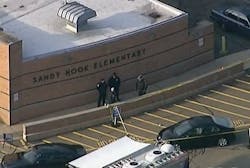Lessons learned in Sandy Hook shootings serve to launch fresh security strategies
The shooting that claimed the lives of 20 children and six adults in December 2013 at Sandy Hook Elementary School in Newtown, Conn. proved to be a turning point in the way security professionals and school administrators viewed campus security.
In a keynote address at a symposium on school security late last year, Dr. Ronald Stephens, the executive director of the National School Safety Center, asked members of the audience where school and security professionals go from here as they coordinate their safety strategies. Now, almost two years after Sandy Hook, we are still asking those same questions.
Wednesday morning at the ISC West security conference in Las Vegas, a team of experts offered their perspective on what the new security roadmap should look like as we move forward. The fact that each is currently involved in ongoing school security projects in Newtown certainly provided instant credibility.
“We have learned that to be successful you must take a multi-disciplinary approach to developing a proper school security program,” said Brian Coulombe, a principal with DVS Security Consulting & Engineering. “All the different voices need to be heard and must be at the table to create a workable solution. So we are talking about not only law enforcement and school administrators, but teachers, first responders and IT administrators. The focus here is trying to prevent these types of incidents from happening. To help make this possible, we stress three key areas – deterrence, detection and delay.”
The expected governmental knee jerk reactions began soon after the shootings, with government and community leaders weighing all options from arming teachers, posting retired police officers on campus, regulating violent video games, to creating more robust mental health programs in the schools and in the communities; and of course, tightening the nation’s gun control laws. Unfortunately, security professionals acknowledge that protecting any open campus environment is almost impossible. But providing schools and law enforcement actionable and credible information can certainly reduce the chance of violent incidents so says Phil Santore, the managing principal for DVS Security Consulting & Engineering, who has more than three decades of security consulting experience.
Santore and his fellow panel members endorsed approaching campus security in a layered manner that starts at the perimeter of the school grounds and works its way all the way into the classroom. “Creating a secured perimeter is extremely important, since the more time you have to assess a potential threat, the more time you have to react to it,” Santore explained. “The goal here to be able to provide as much credible information to first responders should the situation escalate into a crisis.”
Julia McFadden, AIA, who is currently an associate principal with Svigals + Partners in New Haven, is part of the current Sandy Hook planning team. For her, ensuring a secure outcome to a school security project must include strong architectural input and guidance.
“From an architectural perspective, you want to establish ownership of the campus perimeter with clear boundaries, controlled access and clear sightlines,” said McFadden, who also stressed that incorporating basic CPTED concepts into school exterior and interior design can provide a cost-effective line of defense for cash-strapped school systems. She pointed out that simply taking advantage of campus topology to create natural barriers and traffic funnels, along with strategic lighting can compliment security technology purchases.
Mark Pompano, the director of security for Newtown Public Schools, has spearheaded reforms in the district’s emergency response policies and procedures by creating response teams that take proactive steps in addressing potential incidents. Pompano created his CRT approach immediately after the 2012 shootings, with the intent to provide administrators and law enforcement real-time information in the event of a crisis.
“The goal is to give everyone time to assess and react so we are confident that our response is the right response. The key here is to buy enough time to make balanced operational decisions,” Pompano said, adding that the district has also changed operational policy for teachers and students when they leave the confines of the school building, requiring an open line of communication between the teacher and the office. Video cameras have also been expanded to outside play areas.
Perhaps the most challenging issue Pompano and his staff have had to deal with since the incident was the complete overhaul of how school administrators vet and issue credentials to visitors. He admitted that prior to the shootings; school facilities were considerably more accessible to the community. Now there are tighter restrictions on both parent and vendor visiting policies, with an enhanced visitor management and badging system, which has helped cut visitor traffic by almost 50 percent.
“It is crucial to vet everyone who comes onto your campus and into your buildings,” he said.
About the Author
Steve Lasky
Editorial Director, Editor-in-Chief/Security Technology Executive
Steve Lasky is Editorial Director of the Endeavor Business Media Security Group, which includes SecurityInfoWatch.com, as well as Security Business, Security Technology Executive, and Locksmith Ledger magazines. He is also the host of the SecurityDNA podcast series. Reach him at [email protected].

